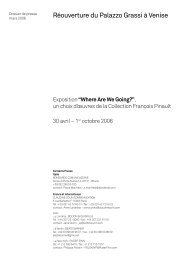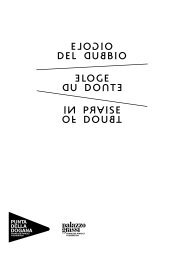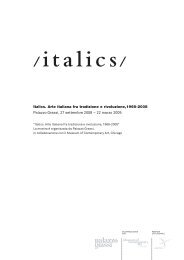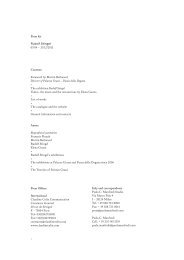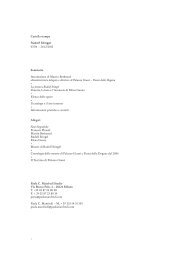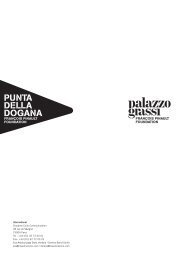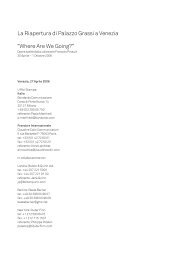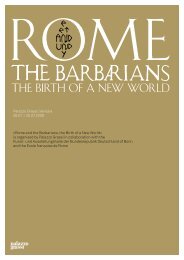Scaricare la presentazione dei tre video. - Palazzo Grassi
Scaricare la presentazione dei tre video. - Palazzo Grassi
Scaricare la presentazione dei tre video. - Palazzo Grassi
Create successful ePaper yourself
Turn your PDF publications into a flip-book with our unique Google optimized e-Paper software.
TEATRINO<br />
ANRI SALA<br />
1395 DAYS<br />
WITHOUT RED<br />
2011, 43’<br />
1395 Days without Red (2011) è frutto di una<br />
col<strong>la</strong>borazione tra Anri Sa<strong>la</strong> e il compositore<br />
Ari Benjamin Meyers. Il film ricostruisce <strong>la</strong> vita<br />
quotidiana degli abitanti di Sarajevo tra il 1992<br />
e il 1996, durante l’assedio del<strong>la</strong> città (il titolo allude<br />
al<strong>la</strong> durata dell’assedio e al colore che non si doveva<br />
indossare se non si voleva attirare l’attenzione <strong>dei</strong><br />
cecchini). La macchina da presa segue una donna,<br />
interpretata dall’attrice spagno<strong>la</strong> Maribel Verdú, che<br />
attraversa una Sarajevo quasi deserta, ripercorrendo<br />
il tragitto coperto ogni giorno da migliaia di cittadini,<br />
minacciati dal fuoco imp<strong>la</strong>cabile <strong>dei</strong> cecchini. È noto<br />
che durante l’assedio l’Orchestra sinfonica non cessò<br />
mai <strong>la</strong> sua attività. Le riprese dell’orchestra che prova<br />
<strong>la</strong> Sesta sinfonia di Ciajkovskij, <strong>la</strong> Patetica,<br />
con i musicisti che si fermano per ripetere le varie<br />
parti del<strong>la</strong> sinfonia, si alternano alle sequenze del<strong>la</strong><br />
donna, che si arresta in sincrono con le interruzioni<br />
del<strong>la</strong> musica, riprendendo poi il suo cammino, come<br />
se fossero le note che le risuonano in testa a darle<br />
<strong>la</strong> forza di andare avanti.
1395 Days without Red<br />
A film by Anri Sa<strong>la</strong><br />
In col<strong>la</strong>boration with Liria Bégéja<br />
From a project by Šej<strong>la</strong> Kamerić and Anri Sa<strong>la</strong><br />
in col<strong>la</strong>boration with Ari Benjamin Meyers<br />
Commissioned by Artangel<br />
Courtesy: Marian Goodman Gallery, New York;<br />
Hauser Wirth, London, Zurich<br />
© ANRI SALA, ŠEJLA KAMERIC,<br />
ARTANGEL, SCCA / PRO.BA 2011<br />
1395 Days without Red (2011) is the result<br />
of a col<strong>la</strong>boration between Anri Sa<strong>la</strong> and<br />
composer Ari Benjamin Meyers. It recreates<br />
the daily living conditions of people in<br />
Sarajevo during the siege that <strong>la</strong>sted from<br />
1992 to 1996 (the title alludes to the length<br />
of the siege and to the color that the<br />
residents stopped wearing in order to avoid<br />
attracting the attention of snipers).<br />
The camera follows a woman, p<strong>la</strong>yed by<br />
the Spanish ac<strong>tre</strong>ss Maribel Verdú, making<br />
her way through a nearly deserted Sarajevo<br />
in a re-enactment of the route taken daily<br />
by thousands of citizens under threat of<br />
sniper fire. It is a known fact that<br />
throughout the siege, the Sarajevo<br />
Symphony Orchestra continued to perform.<br />
In Sa<strong>la</strong>’s work, the orchestra is shown<br />
rehearsing Tchaikovsky’s 6 th symphony,<br />
the Pathétique, and as the musicians pause<br />
to repeat various sections of the symphony,<br />
so the woman halts in synchrony with them,<br />
before resuming her walk through the city,<br />
as if the music resounded in her head and<br />
gave her the s<strong>tre</strong>ngth to carry on.<br />
1395 Days without Red (2011) est le fruit<br />
d’une col<strong>la</strong>boration en<strong>tre</strong> Anri Sa<strong>la</strong> et le<br />
compositeur Ari Benjamin Meyers.<br />
Le film reconstruit les conditions de vie au<br />
quotidien des résidents de Sarajevo alors<br />
assiégée, en<strong>tre</strong> 1992 et 1996 (le ti<strong>tre</strong> évoque<br />
<strong>la</strong> durée du siège et <strong>la</strong> couleur qu’il fal<strong>la</strong>it<br />
ne pas porter pour éviter de constituer une<br />
cible trop visible pour les snipers).<br />
Une femme, jouée par l’actrice espagnole<br />
Maribel Verdú, traverse Sarajevo presque<br />
déserte, en suivant un chemin emprunté<br />
tous les jours par des milliers de citoyens<br />
sous <strong>la</strong> menace constante des tireurs.<br />
Durant toute cette période, l’Orches<strong>tre</strong><br />
Symphonique de Sarajevo n’a jamais cessé<br />
de jouer. Les scènes où l’orches<strong>tre</strong> répète<br />
<strong>la</strong> symphonie Pathétique de Tchaïkovski,<br />
montrant les musiciens s’interrompre pour<br />
changer de mouvement, alternent avec les<br />
séquences présentant <strong>la</strong> femme traversant<br />
<strong>la</strong> ville. Celle-ci s’arrête en synchronie avec<br />
les silences de <strong>la</strong> musique, comme si c’était<br />
les notes résonnant dans sa tête qui lui<br />
donnaient le courage d’avancer.
TEATRINO<br />
LORIS GRÉAUD<br />
THE SNORKS:<br />
A CONCERT<br />
FOR CREATURES<br />
2012, 22’<br />
Il film di Loris Gréaud è una “sinfonia subacquea hip<br />
hop”, che nasce dal<strong>la</strong> fascinazione dell’artista per<br />
il mondo degli abissi e gli organismi bioluminescenti<br />
che li abitano, <strong>la</strong> cui luce, secondo i biologi, produce<br />
l’effetto di “fuochi d’artificio sottomarini” e risulta<br />
visibile anche dallo spazio. Dopo <strong>tre</strong> anni di ricerche<br />
in col<strong>la</strong>borazione con scienziati, esperti di pirotecnica<br />
e musicisti, Gréaud ha realizzato il film chiedendo<br />
al gruppo hip hop americano Antipop Consortium<br />
di comporre le musiche. Gréaud ha <strong>la</strong>vorato anche<br />
con due artisti dell’industria cinematografica:<br />
l’attrice Charlotte Rampling e il regista David Lynch,<br />
che raccontano <strong>la</strong> storia del progetto. Quest’ultimo<br />
si inscrive in un processo durato ol<strong>tre</strong> <strong>tre</strong> anni<br />
e costituito da vari momenti: uno spettacolo<br />
pirotecnico, un concerto nello studio dell’artista,<br />
delle proiezioni in Times Square a New York.<br />
Nel film <strong>la</strong> colonna sonora viene trasmessa negli<br />
abissi attraverso apparecchiature subacquee,<br />
mettendo in luce il vero intento dell’artista:<br />
l’esplorazione delle possibilità di comunicazione<br />
tra le specie.
The Snorks: A Concert for Creatures<br />
A project and film<br />
by Loris Gréaud, 2012<br />
© LORIS GRÉAUD,<br />
GRÉAUDSTUDIO FILM INC.<br />
Loris Gréaud’s film is an “underwater hip<br />
hop symphony” stemming from the artist’s<br />
fascination with the ocean depths and the<br />
bioluminescent organisms living there and<br />
whose light is described by biologists as<br />
illuminating the bottom of the seas like<br />
underwater fireworks. After three years<br />
of research and col<strong>la</strong>boration with<br />
scientists, pyrotechnicians and musicians,<br />
Gréaud directed the film together with the<br />
North American abstract hip hop group<br />
Antipop Consortium who composed the<br />
music. Gréaud also invited two artists from<br />
the film industry: ac<strong>tre</strong>ss Charlotte<br />
Rampling and film director David Lynch,<br />
who narrate the story of the project.<br />
This is part of a process that <strong>la</strong>sted over<br />
three years and involved different medias,<br />
from the production of fireworks to a<br />
concert in the artist’s studio and some<br />
projections in Times Square, New York.<br />
The film shows how the music composed<br />
was transmitted as a concert to the<br />
deep-sea creatures via sub-aquatic<br />
equipments and highlights Gréaud’s main<br />
interest: an exploration of the possibilities<br />
of inter-species communication.<br />
Le film de Loris Gréaud est une « symphonie<br />
hip-hop des fonds marins » née de <strong>la</strong><br />
fascination de l’artiste pour les profondeurs<br />
des océans et les organismes<br />
bioluminescents qui y vivent. Leur lumière,<br />
d’après les chercheurs, produit l’effet de<br />
feux d’artifice sous-marins et serait même<br />
visible de l’espace. Après trois ans de<br />
recherches en col<strong>la</strong>boration avec des<br />
scientifiques, des pyrotechniciens et des<br />
musiciens, Gréaud a réalisé ce film avec<br />
le groupe américain de hip hop Antipop<br />
Consortium, qui en a composé <strong>la</strong> bande<br />
originale. Gréaud a invité deux au<strong>tre</strong>s<br />
artistes de l’industrie du cinéma : l’actrice<br />
Charlotte Rampling et le réalisateur David<br />
Lynch, qui racontent l’histoire du projet.<br />
Celui-ci s’inscrit dans un processus qui a<br />
duré plus de trois ans et a investi des média<br />
très différents, de <strong>la</strong> production d’un feu<br />
d’artifice à un concert dans l’atelier<br />
de l’artiste, en passant par des projections<br />
sur Times Square à New York. Le film<br />
documente <strong>la</strong> transmission de <strong>la</strong> musique<br />
aux créatures sous-marines par<br />
l’intermédiaire de stations subaquatiques<br />
et met en lumière le principal objectif<br />
de ce projet : l’exploration des possibilités<br />
de communication en<strong>tre</strong> les espèces.
TEATRINO<br />
PHILIPPE<br />
PARRENO<br />
MARILYN<br />
2012, 23’<br />
Marilyn (2012), opera incentrata sull’idea<br />
di celebrare una persona defunta, o di ritrarre<br />
un fantasma, propone un’evocazione fittizia<br />
di Marilyn Monroe, icona del<strong>la</strong> cultura popo<strong>la</strong>re,<br />
ed è ambientata nel<strong>la</strong> suite del Waldorf Astoria<br />
di New York in cui l’attrice viveva negli anni<br />
cinquanta. La sua presenza è riprodotta attraverso<br />
<strong>tre</strong> algoritmi che vengono utilizzati nel<strong>la</strong> biometria<br />
per identificare un individuo e che corrispondono<br />
rispettivamente al<strong>la</strong> voce, al<strong>la</strong> calligrafia e al<br />
riconoscimento ocu<strong>la</strong>re. La macchina da presa vede<br />
con gli occhi di Marilyn, un computer ne ricostruisce<br />
<strong>la</strong> voce che descrive ciò che gli occhi vedono e un<br />
robot scrive con <strong>la</strong> sua calligrafia ciò che <strong>la</strong> voce<br />
racconta. Mediante un’equazione matematica<br />
e il ricorso al<strong>la</strong> robotica, ci viene proposto un essere<br />
quasi umano, secondo le parole dell’artista stesso<br />
“un’immagine incarnata”. Philippe Parreno ha<br />
acconsentito in via del tutto eccezionale a presentare<br />
<strong>la</strong> sua opera in una sa<strong>la</strong> di proiezione, anche se<br />
generalmente è ospitata in uno spazio espositivo<br />
vero e proprio, nelle condizioni di apparizione<br />
e scomparsa richieste dal <strong>la</strong>voro.
© PHILIPPE PARRENO<br />
Marilyn (2012) is a work focused on<br />
the idea of celebrating a dead person,<br />
of portraying a ghost. It is a fictitious<br />
evocation of Marilyn Monroe, the icon<br />
of popu<strong>la</strong>r culture, and is set in the suite<br />
of the Waldorf Astoria in New York, where<br />
the ac<strong>tre</strong>ss lived in the 1950s. The three<br />
algorithms that are used in biometrics to<br />
identify an individual and which respectively<br />
correspond to the voice, the handwriting,<br />
and iris recognition, reproduce Marilyn’s<br />
presence. The camera sees with her eyes,<br />
a computer reconstructs her voice to<br />
describe what the eyes see, and a robot<br />
writes with her calligraphy what the voice<br />
says. Through the use of a mathematical<br />
equation and robotics, the work produces<br />
a figure that is almost human, in the words<br />
of the artist “an embodied image”.<br />
Philippe Parreno has exceptionally agreed<br />
to present this work in a screening room,<br />
even though it is usually disp<strong>la</strong>yed in<br />
a proper exhibition space, in the conditions<br />
of appearing and disappearing that<br />
the work requires.<br />
Marilyn (2012) est né de l’intérêt de<br />
l’artiste pour l’idée de <strong>la</strong> célébration d’une<br />
personne disparue, du portrait d’un<br />
fantôme. Il est une évocation fictionnelle de<br />
Marilyn Monroe, icône culturelle popu<strong>la</strong>ire,<br />
dans une suite de l’hôtel Waldorf à New<br />
York, où elle a vécu dans les années 1950.<br />
Sa présence est perceptible grâce aux trois<br />
algorithmes utilisés dans <strong>la</strong> biométrie pour<br />
identifier un individu, correspondant<br />
respectivement à <strong>la</strong> voix, l’écriture<br />
et les yeux. La caméra devient ses yeux,<br />
l’ordinateur reconstitue sa voix et un robot<br />
recrée son écriture, qui retranscrit ce que<br />
dit <strong>la</strong> voix. A l’aide d’équations<br />
mathématiques et de <strong>la</strong> robotique, un ê<strong>tre</strong><br />
presque humain prend vie, une « image<br />
incarnée », pour reprendre les paroles<br />
de l’artiste lui-même. Philippe Parreno<br />
a exceptionnellement accepté de présenter<br />
pour nous cette œuvre dans un dispositif<br />
de salle de cinéma, même si elle est<br />
destinée à ê<strong>tre</strong> présentée dans un espace<br />
d’exposition, dans les conditions<br />
d’apparition et de disparition que dicte<br />
le travail.






